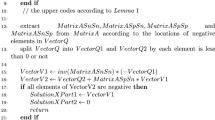Abstract
We consider the linear complementarity problem (LCP),w=Az + q, w⩾0,z⩾0,w T z=0, when all the off-diagonal entries ofA are nonpositive (the class of Z-matrices), all the proper principal minors ofA are positive and the determinant ofA is negative (the class of almost P-matrices). We shall call this the class of F-matrices. We show that ifA is a Z-matrix, thenA is an F-matrix if and only if LCP(q, A) has exactly two solutions for anyq⩾0,q≠0, and has at most two solutions for any otherq.
Similar content being viewed by others
References
A. Berman and R.J. Plemons,Nonnegative Matrices in the Mathematical Sciences (Academic Press, New York, 1979).
R.W. Cottle, J.S. Pang and R.E. Stone,The Linear Complementarity Problem (Academic Press, Boston, MA, 1992).
K. Fan, “Some matrix inequalities,”Abhandlungen aus dem Mathematischen Seminar der Universität Hamburg 29 (1966), 185–196.
M.S. Gowda, “Applications of degree theory to linear complementarity problems,” Research Report 91-14, Department of Mathematics, University of Maryland Baltimore County (Catonsville, MD, 1991).
G.A. Johnson, “A generalization of N-matrices,”Linear Algebra and its Applications 48 (1982) 201–217.
M. Kojima and R. Saigal, “On the number of solutions to a class of linear complementarity problems,”Mathematical Programming 17 (1979) 136–139.
S.R. Mohan and R. Sridhar, “On characterizing N-matrices using linear complementarity,”Linear Algebra and its Applications 160 (1992) 231–245.
K.G. Murty, “On the number of solutions to the complementarity problem and spanning properties of complementary cones,”Linear Algebra and its Applications 5 (1972) 65–108.
H. Nikaido,Convex Structures and Economic Theory (Academic Press, New York, 1968).
C. Olech, T. Parthasarathy and G. Ravindran, “Almost N-matrices and linear complementarity,”Linear Algebra and its Applications 145 (1991) 107–125.
T. Parthasarathy and G. Ravindran, “N-matrices,”Linear Algebra and its Applications 139 (1990) 89–102.
R. Saigal, “On the class of complementary cones and Lemke's algorithm,”SIAM Journal on Applied Mathematics 23 (1972) 46–60.
H. Samelson, R.M. Thrall and O. Wesler, “A partition theorem for Euclideann-space,”Proceedings of the American Mathematical Society 9 (1958) 805–807.
S. Xu, “Sign-reversal property for F-matrices and N-matrices,” unpublished manuscript.
Author information
Authors and Affiliations
Additional information
Research supported by AFOSR-89-0512.
Rights and permissions
About this article
Cite this article
Miao, J. Ky Fan's N-matrices and linear complementarity problems. Mathematical Programming 61, 351–356 (1993). https://doi.org/10.1007/BF01582156
Received:
Revised:
Issue Date:
DOI: https://doi.org/10.1007/BF01582156




